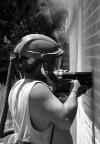Engineering control technologies to reduce occupational silica exposures in masonry cutting and tuckpointing
- PMID: 19618812
- PMCID: PMC2708661
- DOI: 10.1177/00333549091244S112
Engineering control technologies to reduce occupational silica exposures in masonry cutting and tuckpointing
Abstract
Objectives: A number of tasks in construction generate worker overexposures to respirable crystalline silica dust, which is a significant contributor to occupational mortality and morbidity. This study evaluated the performance of commercially available engineering controls used in dusty construction tasks commonly performed by bricklayers.
Methods: Local exhaust ventilation (LEV) controls for a portable abrasive cutter and for tuckpointing grinders were examined at a bricklayers' training center, as were two stationary wet saws. Personal breathing zone air samples were collected with and without the use of LEV or water suppression during simulated concrete block cutting, brick cutting, and tuckpointing.
Results: Compared with the use of no exposure control during block and brick cutting, the portable LEV unit significantly reduced mean respirable quartz exposures by 96% for block cutting and 91% for brick cutting (p < 0.01). The use of stationary wet saws was also associated with 91% reductions in exposure (p < 0.01). For tuckpointing, the reductions in mean respirable quartz concentrations were between 91% and 93% with the LEV controls (p < 0.05).
Conclusions: Reductions of up to 96% in mean respirable quartz concentration were observed between control and no-control scenarios. These reductions with commercially available off-the-shelf tools demonstrate the effectiveness of engineering control interventions to reduce crystalline silica exposures in construction. Strategies to further improve control performance and approaches for increasing control interventions in construction are needed.
Figures





Similar articles
-
Laboratory evaluation to reduce respirable crystalline silica dust when cutting concrete roofing tiles using a masonry saw.J Occup Environ Hyg. 2010 Apr;7(4):245-51. doi: 10.1080/15459620903579695. J Occup Environ Hyg. 2010. PMID: 20169490 Clinical Trial.
-
Experimental Evaluation of Respirable Dust and Crystalline Silica Controls During Simulated Performance of Stone Countertop Fabrication Tasks With Powered Hand Tools.Ann Work Expo Health. 2017 Jul 1;61(6):711-723. doi: 10.1093/annweh/wxx040. Ann Work Expo Health. 2017. PMID: 28927166 Free PMC article.
-
Effectiveness of dust control methods for crystalline silica and respirable suspended particulate matter exposure during manual concrete surface grinding.J Occup Environ Hyg. 2010 Dec;7(12):700-11. doi: 10.1080/15459624.2010.527552. J Occup Environ Hyg. 2010. PMID: 21058155
-
Engineering controls for selected silica and dust exposures in the construction industry--a review.Appl Occup Environ Hyg. 2003 Apr;18(4):268-77. doi: 10.1080/10473220301406. Appl Occup Environ Hyg. 2003. PMID: 12637237 Review.
-
Reported exposures to respirable crystalline silica during construction tasks and guidance for harmonizing future research.J Occup Environ Hyg. 2024 Aug;21(8):602-622. doi: 10.1080/15459624.2024.2357715. Epub 2024 Jul 23. J Occup Environ Hyg. 2024. PMID: 39042882 Review.
Cited by
-
The power of local action in occupational health: the adoption of local exhaust ventilation in the Chicago tuckpointing trade.Int J Occup Environ Health. 2016 Apr;22(2):142-50. doi: 10.1080/10773525.2016.1187476. Epub 2016 Jun 30. Int J Occup Environ Health. 2016. PMID: 27362634 Free PMC article.
-
A New Test Bench System for Hammer Drills: Validation for Handle Vibration.Int J Ind Ergon. 2017 Nov;62:17-20. doi: 10.1016/j.ergon.2016.08.001. Epub 2016 Aug 29. Int J Ind Ergon. 2017. PMID: 29123327 Free PMC article.
-
A probabilistic approach for economic evaluation of occupational health and safety interventions: a case study of silica exposure reduction interventions in the construction sector.BMC Public Health. 2020 Feb 11;20(1):210. doi: 10.1186/s12889-020-8307-7. BMC Public Health. 2020. PMID: 32046683 Free PMC article.
-
Field Evaluation of N95 Filtering Facepiece Respirators on Construction Jobsites for Protection against Airborne Ultrafine Particles.Int J Environ Res Public Health. 2018 Sep 7;15(9):1958. doi: 10.3390/ijerph15091958. Int J Environ Res Public Health. 2018. PMID: 30205526 Free PMC article.
-
Design, Implementation, and Evaluation of Industrial Ventilation Systems and Filtration for Silica Dust Emissions from a Mineral Processing Company.Indian J Occup Environ Med. 2021 Oct-Dec;25(4):192-197. doi: 10.4103/ijoem.IJOEM_55_19. Epub 2021 Dec 31. Indian J Occup Environ Med. 2021. PMID: 35197669 Free PMC article.
References
-
- Occupational Safety and Health Administration, Department of Labor (US) National Emphasis Program—crystalline silica. [cited 2008 Feb 26]; OSHA instruction directive number: CPL 03-00-007. Effective date: January 24, 2008. Available from: URL: http://www.osha.gov/OshDoc/Directive_pdf/CPL_03-00-007.pdf.
-
- Occupational Safety and Health Administration; Department of Labor (US) Prerule stage: occupational exposure to crystalline silica. Federal Register. 2007;72(236):69884–5.
-
- U.S. House of Representatives. Report of the committee on rules to accompany H. Res. 878. Washington: U.S. House of Representatives; 2007. 110th congress, 1st session. Report 110-497:326.
-
- State of California, Department of Industrial Relations. >Control of employee dust exposure from concrete and masonry operations. [cited 2008 Feb 27]; Construction safety orders, chapter 4, subchapter 4, article 4. New section 1530.1. Available from: URL: http://www.dir.ca.gov/oshsb/concreteandmasonry0.html.
-
- National Institute of Occupational Safety and Health (US) Cincinnati: NIOSH; 1986. Occupational respiratory diseases. DHHS/NIOSH Publication No. 86-102.
Publication types
MeSH terms
Substances
Grants and funding
LinkOut - more resources
Full Text Sources
Medical

